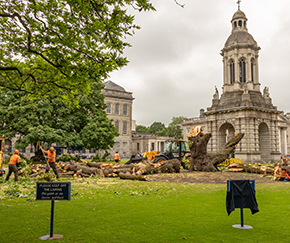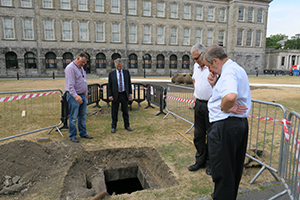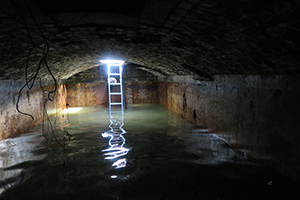Interviews
 Trinity's Iconic Oregon Maple Tree Collapse
Trinity's Iconic Oregon Maple Tree Collapse
Name: Professor John Parnell
Title: Professor of Systematic Botany, Senior Dean and Chair of Grounds and Gardens Advisory Committee, at Trinity College Dublin
The iconic Oregon Maple that stood in Library Square for about 175 years fell dramatically and unexpectedly on an exceptionally warm summer’s night in June 2018. No one was injured in the incident and there was no damage to the surrounding buildings.
We sat down with Professor John Parnell in his Laboratory (the College herbarium), which holds a 300,000 strong collection of dried plant material dating back to circa 1722, to discuss the cause of the great collapse and more.

Image credit: John Brady
Tell me a little bit about your own area of research.
My base of botanical experience is European but since coming to Trinity I have focussed my research interests on the palaeotropics. Most of my paleotropical work has concentrated on revisions for the Flora of Thailand; recently published work covers the Lentibulariaceae and Buxaceae of that country.
What caused the fall of the Oregon Maple tree on Library Square in June?
Stress, disease, old age and lack of a sufficient supply of water are the probable causes of death of the majestic 175-year-old Oregon Maple trees. This species is native to river banks and lake shores of the Pacific northwest of America, where the average rainfall is about 3,500mm (ca. 650mm in Dublin). The Trinity maples were therefore growing in exceptionally dry conditions and coming towards the end of their natural life.
Trinity frequently gets its trees surveyed by international experts, Bartlett. The latest survey, in April, raised concerns about the condition of three of the Oregon Maples on campus. It was not believed, however, that any were in immediate danger of collapse. And the hope was that their lives could be prolonged by remedial work for at least another 10 years.
It is probable that the collapse was at least in part also due to climate change – the very hot weather and the summer drought caused exceptional physiological and physical stress for a tree that was not in tip-top condition.
Why were two further Maple trees removed a month later in July?
Unfortunately both trees contained much wood damaged by wood-decaying fungi and the risk of them falling and injuring passers-by and damaging the surrounding buildings was simply too great.
Who planted Trinity’s historic Oregon Maple trees?
Trinity does not hold a record of who planted the Library Square Maples or precisely when, though the tree rings indicate that they were planted around 1845, most likely by a former Trinity student, Thomas Coulter. The species was introduced to Britain for cultivation purposes by the explorer David Douglas who sent seeds to the Royal Horticultural Society in London in 1827. All of the oldest remaining specimens in Britain date from this time and most are reaching the end of their normal life-span (80 and 200 years). Douglas knew, met and worked with Thomas Coulter in Monterey, California.
Coulter became the first curator of the Trinity herbarium in 1840. On 9th July 1840 Coulter wrote: “My arrangement with College is this – I make over to them by deed my whole herbarium, a pre gift, and they make me Curator of it with Fellows chambers and commons (worth about £40 per annum) and £100 cash per annum for the present, to be made £300 (per annum) on the death of Dr Stokes. So far all right, but they insist on another condition, which as it happens is not a disagreeable one, but you must keep it to yourself – it is that I must accept the chair of Botany when vacant if they elect me – very hard! isn’t it.”
What happened to the Oregon Maple trees after they were removed?
The salvaged wood is being stored safely in the correct environmental conditions in Trinity. There have been discussions about making commemorative pieces of furniture or plinths with the large pieces of remaining timber. There are also plans to use some of the wood to make beautiful pieces that will be for sale in the Trinity Gift Shop.
To date a wonderful range of wood products from Trinity’s felled trees has been made in collaboration with Caulfield’s Country Boards; there are on sale on campus in the Trinity Gift Shop and online on www.trinitygiftshop.ie.
Tell us about the plans for replanting in Library Square?
There are no immediate plans to replant on Library Square. We have just received the preliminary results of a ground penetrating radar survey of Library Square. The archaeology of the area certainly needs to be considered before we replant: there are definitely items requiring further investigation beneath the square. For example, during the removal of one of the Oregon Maple trees we discovered a large water tank. We subsequently discovered that the construction of the tank likely followed direction by the Board in June 1836. The Board’s minutes note that the ‘corporation was to bring a 4” water main to the centre of Library Square, for which the College was to pay £110’. The same minute had a reference to fire precautions, and in the following April the Board directed that ‘the fire engine is to be put in order’.


Caption L-R: Brendan Leahy, Head of Estates and Facilities, Provost, Dr Patrick Prendergast, David Hackett, Environmental Services Co-ordinator and Paul Mangan, Former Director of Estates and Facilities observe the water tank beneath Library Square.
What considerations now need to be made before planning new trees on Campus?
There are a number of factors that we need to take into account before we plant any trees on Campus. The primary considerations are that the soil in College is quite poor and the climate of the College is really quite difficult. Although pollution levels have dramatically fallen over the past 20-25 years, there are other changes that make it problematic for trees to do well on the Campus. In general, we now know it is really difficult to get trees to survive. So, one of the first things to take into account is experience: what trees have done well here in the past. The second consideration is climate change and what impact that will have on the trees over their lifespan. The third factor is how a new tree would fit into the landscape of the College as a whole: we need to plant in a sympathetic way using trees that do not overwhelm the fine architecture of the University. Finally, we are very keen to encourage biodiversity in the College and so trees that are pollinator attractive for bees are highly desirable.
What is your favourite place on Campus?
It is the new garden square directly outside the Botany Building. It succeeds as a social place for people to meet and study. Also, the plants are very attractive and flower over a long period so it looks good for a lot of the year. It is also sympathetic to the buildings surrounding it – especially the Botany Building and the adjacent Fitzgerald Building.
How do students benefit from studying our trees/plant life in College?
The students benefit enormously from doing hands on work outside. A lot of what we do now in the University is largely indoors and to some extent divorced from hands-on outdoor experience. And, I believe that if you don’t have people who can go into the outside world – into the field as I would call it – and identify plants and see how they perform then nothing really works. Training people in these sorts of skills has, perhaps, become less popular in Europe than it used to be but it is still vitally important in developing countries where people are very conscious of the loss of the natural environment and want to do everything in their power to try and prevent that loss.

